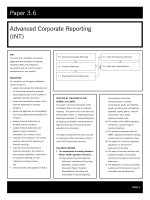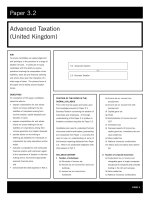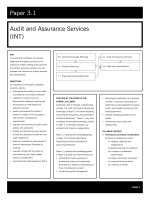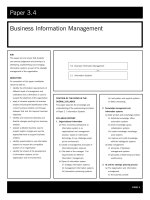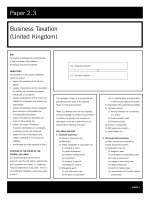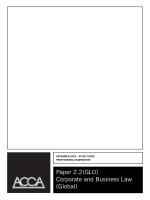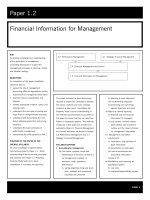acca test book Advanced Taxation pot
Bạn đang xem bản rút gọn của tài liệu. Xem và tải ngay bản đầy đủ của tài liệu tại đây (330.79 KB, 10 trang )
PAGE 3
AIM
To ensure candidates can apply judgement
and technique in the provision of a range of
taxation services. In particular to equip
candidates with the ability to resolve
problems involving the computation of tax
liabilities, basic tax and financial planning
and which draw upon the interaction of a
wide range of taxes. The primary focus of
the paper will be based around taxation
issues.
OBJECTIVES
On completion of this paper candidates
should be able to:
• prepare computations for and advise
clients on issues relating to the tax
liabilities of individuals arising from
income receipts, capital disposals and
transfers of value
• prepare computations for and advise
clients on issues relating to the tax
liabilities of corporations arising from
income generation and capital disposals
• provide advice on minimising or
deferring tax liabilities for individuals or
corporations by using exemptions and/or
reliefs
• evaluate a corporation's and individual's
financial position with particular regard
to the importance of taxation in decision
making and to recommend appropriate
personal financial plans
and
• demonstrate the skills expected in Part 3.
Paper 3.2
Advanced Taxation
(United Kingdom)
POSITION OF THE PAPER IN THE
OVERALL SYLLABUS
This is the final tax paper and builds upon
the knowledge acquired in Paper 2.3
Business Taxation concerning the taxation of
businesses and employees. A thorough
understanding of the Paper 2.3 syllabus is
therefore considered requisite for Paper 3.2.
Candidates also need to understand formats
of accounts used for sole traders, partnerships
and companies from Paper 1.1 and also the
need to have an understanding of some of
the financial reporting standards from Paper
2.5. There is no substantial integration with
other papers in Part 3.
SYLLABUS CONTENT
1 Taxation of individuals
(a) Principles of income tax
(b) Income tax on income from land and
buildings
(c) Income tax on income from
Investment
(d) Income tax on income from
employment
(e) Income tax on income from self-
employment
(f) Capital gains tax
(g) Trusts
(h) Administration of income tax and
CGT
(i) Inheritance tax
(j) Overseas aspects of income tax,
capital gains tax, inheritance tax and
value added tax
(k) Value added tax
(l) National insurance contributions
(m) Stamp duty and stamp duty reserve
tax.
2 Taxation of corporate businesses
(a) Corporation tax on income and
chargeable gains of single companies
and groups of companies and consortia
trading in the UK and overseas
(b) Value added tax
(c) National insurance contributions
3.2 Advanced Taxation
2.3 Business Taxation
PAGE 4
(d) Stamp duty and stamp duty reserve
tax.
3 Financial planning
(a) Sources of Finance
(b) Personal Financial Planning
(c) Financial Services Products
(d) The Regulatory Framework.
EXCLUDED TOPICS
Note that the labelling of excluded topics
relates to the relevant section of the
syllabus
1 Taxation of individuals
(c) Income tax on income from
investments
(i) detailed knowledge of anti-
avoidance procedures
(d) Income tax on income from
employment
(i) PAYE system
(ii) an employee share ownership
plan (ESOP) will not be examined
in its own right
(e) Income tax on income from self-
employment
(i) averaging of farmers profits
(ii) averaging of profits for authors
and creative artists
(iii) the allocation of notional profits
and losses for a partnership
(iv)research and development
expenditure
(v) capital allowances for agricultural
buildings, patents, flats above
shops, scientific research and
know-how
(vi)in respect of industrial buildings
allowance: enterprise zones,
initial allowances and the sale of
an industrial building at less than
original cost following a period of
non industrial use (note that
sales for more than original cost
are examinable)
(vii) detailed anti-avoidance legislation.
(f) Capital gains tax
(i) assets held at 31 March 1982
(ii) the grant of a lease or sub-lease
out of either a freehold, long
lease or short lease
(iii) a detailed knowledge of the
statements of practice on
partnership capital gains
(iv) retirement relief
(v) relief for losses on loans made to
traders.
(h) Trusts
(i) overseas aspects
(j) Inheritance Tax
(i) double grossing up on death
(ii) pre 18 March 1986 lifetime
transfers
(iii) woodlands relief
(iv)conditional exemption for
heritage property
(v) relief on relevant business
property and agricultural property
given as exempt legacies
(vi) valuation of an annuity or an
interest in possession where the
trust interest is subject to an
annuity
(v) detailed knowledge of the double
charges legislation
(vi)an accumulation and maintenance
trust ceasing to qualify
(vi) double taxation relief calculation
involving the formula A
x C
A+B
(vii) IHT aspects of discretionary
trusts prior to 27 March 1974.
(k) Value added tax
(i) capital goods scheme
(ii) in respect of property and land
leases and do it yourself builders
(iii) flat rate scheme for farmers
(iv) special schemes for retailers.
(l) National insurance contributions
(i) detailed calculation of director's
NIC on a month by month basis –
a knowledge of the annual
earnings period rules (including
where a person becomes a
director part way through a tax
year is, however, required).
(ii) offset of trading losses against
non-trading income (for Class 4
purposes).
2 Taxation of corporate businesses
(a) Corporation tax on income and
chargeable gains of single
companies and groups of companies
and consortia trading in the UK and
overseas
(i) a detailed knowledge of anti-
avoidance provisions (with the
exception of those detailed in the
Study Guide)
Advanced Taxation (United Kingdom) (Continued)
PAGE 5
(ii) corporation tax rates on
companies in the process of
winding up
(iii) 51% groups and group income
elections
(iv) quarterly accounting for income
tax
(v) anti-avoidance provisions where
arrangements exist for a company
to leave a group
(vi)detailed knowledge of double
taxation agreements
(vii) migration of a UK resident
company
(viii) mixer companies
(ix)expense relief in respect of
overseas tax
(x) detailed computational questions
on the carry back and carry
forward of unrelieved foreign tax
(xi)an awareness of these provisions
is required
(xii) detailed computational questions
on the 'onshore pooling' provisions
(xiii) again an awareness of these
provisions is all that is required.
(b) Value added tax
(i) as for individuals.
(c) National insurance contributions
(i) detailed calculations of director's
NIC on a month by month basis –
a knowledge of the annual
earnings period rules (including
where a person becomes a
director part way through a tax
year is, however, required.)
3 Financial planning
(a) Sources of finance
(i) the mortgage code.
(c) Financial services products
(i) detailed knowledge of the
conditions which must be met to
obtain Inland Revenue approval for
an occupational pension scheme
(ii) personal pension rules applicable
prior to 6 April 2001
(iii) knowledge of the different
maximum benefit regimes in
occupational schemes
(iv) calculation of maximum or
actual benefits available on early
or late retirement
(v) calculation of a pension cash
equivalent transfer value.
KEY AREAS OF THE SYLLABUS
All areas of the syllabus may be regarded
as important. The Study Guide details
those areas of particular importance for the
compulsory Section A questions:
APPROACH TO EXAMINING THE
SYLLABUS
The examination is a three hour paper
divided into two sections.
Section A: Two compulsory scenario based
questions worth a total of 50 marks set in
the following areas:
• Non business income tax (although
including employment income)
• Capital gains tax
• Inheritance tax
• Overseas aspects of income tax,
inheritance tax and capital gains tax
• Taxation of trusts
The detailed syllabus areas that will feature
are those set out in italics within the Study
Guide. It is to be noted that these are
primarily the syllabus areas new to 3.2.
Section B: Four 25 mark scenario based
questions from which candidates will be
required to select and answer two. One of
these questions, at least, will focus upon
business taxation. One of the questions in
Section B will have as its main focus personal
financial planning. The other question will
be set on other areas of the syllabus.
The following further guidance should be
noted:
Section A
• To assist in the transition from paper 2.3
to paper 3.2 the compulsory questions,
whilst being set within a scenario involving
some elements of planning and tax
interaction, the emphasis will be on
computation (as an approximate guide
around 50%). A mainly discursive
question is therefore unlikely in Section A.
• As a general guide Section A questions
will primarily focus upon (non-business)
income tax, Inheritance tax and capital
gains tax (both business and non-
business aspects).
• Questions involving mainly financial
Advanced Taxation (United Kingdom) (Continued)
PAGE 6
Paper 3.2: Advanced Taxation (United Kingdom) (Continued)
planning will not feature in Section A.
Note, however, that questions may
involve the taxation elements of, for
example, investment or pension
products (for example calculating an
individual's maximum permissible
pension contributions).
• Whilst no detailed questions will be set
involving income tax aspects of businesses
this will not preclude the inclusion within
questions of, for example, a Schedule D
Case 1 figure (or possibly even series of
figures). Candidates will, however, not
be required to calculate those figures as
part of Section A questions.
• A question will not be set that exclusively
examines the taxation of trusts, stamp
duty or overseas taxation aspects although
these may feature as part of a question.
Section B
• The 25 mark format adopted in Section
B will allow more developed optional
questions.
• Questions can be set in any area of the
syllabus but within the broad overall
guidelines mentioned above.
• The question focusing upon financial
planning is likely to be scenario based,
including some taxation elements, with
candidates required to analyse a particular
set of circumstances and make sensible
financial planning recommendations going
forward. As a guide it is likely that the
pure financial planning elements of this
question will not exceed 60–70%.
• As a general rule it is likely that Section
B questions will examine letter or
report-writing skills to a greater extent
than Section A. Two marks will always
be allocated within one of the Section B
questions covering these skills.
In summary for the June 2003 paper
onwards:
Number
of marks
Section A: 2 compulsory
questions 50
Section B: Choice of 2 from 4
(25 marks each) 50
100
Tax rates, allowances and relevant benefits
will be given in the examination paper.
ADDITIONAL INFORMATION
ACCA adopts a six month rule in that
questions requiring an understanding of
new legislation will not be set until at least
six calendar months after the last day of
the month in which the legislation received
Royal Assent. The same rule applies to the
effective date of the provisions of an Act
introduced by Statutory Instrument. It
would however be considered inappropriate
to examine legislation it is proposed to
repeal or substantially alter.
Knowledge of section numbers will not be
needed to understand questions in this
paper, nor will students be expected to use
them in their answers. If students wish to
refer to section numbers they may do so
and will not be penalised if old, or even
incorrect, section numbers are used.
Names of cases or a detailed knowledge of
judgements are not required but knowledge
of the principles decided in leading cases is
required.
The Study Guide provides more detailed
guidance on the syllabus.
RELEVANT TEXTS
There are a number of sources from which
you can obtain a series of materials written
for the ACCA examinations. These are
listed below:
Foulks Lynch – ACCA's official publisher
Contact number: +44 (0)20 8831 9990.
Website: www.foulkslynch.com
Accountancy Tuition Centre (ATC)
International
Contact number: +44 (0)141 880 6469.
Website: www.ptc-global.com
BPP
Contact number: +44 (0)20 8740 2211.
Website: www.bpp.com
The Financial Training Company
Contact number: +44 (0)174 785 4302.
Website: www.financial-training.com
Candidates may also find the following
textbooks useful:
Advanced Taxation (United Kingdom) (Continued)
PAGE 7
(i) paper 2.3 section 2d (have
scope now for both business and
non business assets including
shares and securities) plus
(ii) exempt assets and disposals
(particularly on disposals arising
at death)
(iii) concept of independent taxation
and transfers between spouses
(iv)timing of disposal (particularly in
the context of conditional
contracts)
(v) losses in the year of death
(vi)variations/disclaimers arising on
death
(vii) connected persons
(viii) payment of tax by instalments
(ix)part disposals
(x) principal private residence relief
(xi)matching rules for shares and
securities
(xii) basic reorganisations and
takeovers (particularly s135 TGGA
1992, the conditions, including for
bona fide commercial purposes,
and the advance clearance
procedure).
(xiii) leases, chattels and wasting
assets
(xiv) compensation and insurance
receipts
(xv) EIS/VCT reinvestment relief
(xvi) appropriations to and from
trading stock
(xvii) gift relief where there is an
immediate charge to IHT (s260
Paper 3.2: Advanced Taxation (United Kingdom) (Continued)
Advanced Taxation (United Kingdom) (Continued)
STUDY SESSIONS
Items in italics refer to syllabus areas that
can be examined within Section A.
1 Taxation of individuals
(a) Principles of income tax
(i) paper 2.3 syllabus section 2a plus
(ii) schedular system
(iii) concept of independent taxation
and jointly held assets
(iv) personal allowances and reliefs
(v) non business charges on income
and Gift Aid
(b) Income tax on income from land and
buildings
(i) income liable
(ii) basis of assessment and
computation of assessable profits
and losses
(iii) reverse premiums
(iv)premiums received on the grant
of a short lease
(v) furnished holiday lettings and
implications
(vi)rent a room relief
(c) Income tax on income from
investments
(i) tax free investments
(ii) schedule D case III
(iii) taxation of savings income and
dividends
(iv)accrued income scheme
(v) schedule D case vi
(vi)double taxation relief
(d) Income tax on income from
employment
(i) paper 2.3 syllabus sections 3a(i),
(ii) and (iv) plus
(ii) share and share option incentive
schemes (approved and
unapproved schemes)
(iii) lump sum receipts
(iv)exempt benefits
(v) personal service companies
(e) Income tax on income from self-
employment
(i) paper 2.3 syllabus sections 2c(i)
– (vii)
(ii) losses on shares in qualifying
companies (section 574 ICTA
1988)
(f) Capital gains tax
A Homer, R Burrows Tolleys Tax Guide
Tolley Publishing ISBN 1860128319
Sonia Gable The Basic Principles of Tax
Taxbriefs Limited ISBN 1902824571
This book can be purchased by registered
students at a 50% discount of £24.50
(RRP £49). This includes P&P to a UK
address, foreign P&P would be extra. To
order, quote your student registration
number and phone +44 (0)20 7250 9067
or fax +44 (0)20 7251 8867 or e-mail
Simon Philip Kelly's Financial Planning for
the Individual Gee ISBN 1860890385
Wider reading is also desirable, especially
regular study of relevant articles in ACCA's
student accountant.
PAGE 8
CGTA 1992)
(g) Trusts
(i) define a trust
(ii) distinguish between interest in
possession trusts and
discretionary trusts
(iii) explain how income tax applies
to:
– interest in possession trusts
– discretionary trusts
(iv)explain how inheritance tax
applies to
– transfers of property into trusts
– transfers of property out of an
interest in possession trust
upon the termination of the
life tenant's interest
– discretionary trusts – ten year
charges and exit charge
(v) define accumulation and
maintenance trusts and explain
their advantages
(vi)explain how capital gains tax
applies to:
– transfers of property into trust
– disposals made by trustees of
settled property within trusts
to third properties
– disposals made by trustees of
settled property within trusts
to beneficiaries
(vii) explain how trusts can be used
in tax and financial planning.
(h) Administration of income tax and
capital gains tax
(i) paper 2.3 syllabus Section 2b
(i) Inheritance tax
(i) basic principles
– explain the terms transfer of
value, chargeable transfer,
potentially exempt transfer,
excluded property and
persons chargeable
– loss of donor principle
(ii) principle chargeable occasions
for IHT
– chargeable lifetime transfers
– potentially exempt transfers
becoming chargeable
– death
(iii)seven year cumulation principle
(iv)concept of grossing up
(v) how IHT is calculated on
chargeable lifetime transfers,
potentially exempt transfers
becoming chargeable and upon
death
(vi)exemptions available covering
lifetime gifts
(vii)concept of independent taxation
particularly in the context of
transfers between spouses
(viii) other exempt transfers (gifts to
charities, political parties, for
national purposes and to housing
associations)
(ix)tax treatment of transfers of
value by close companies
(x) principles of valuation:
– general open market
valuation rule
– specific rules
– related party rules
Advanced Taxation (United Kingdom) (Continued)
(xi)business property and
agricultural property relief and
the relevant conditions applying
(xii) quick succession relief
(xiii) tapering relief
(xiv) determine the value of an
individual's estate at death
including the liabilities and other
deductions that may be taken
into account
(xv) relief available for the
fall in value of assets the subject
of a chargeable lifetime transfer
(xvi) adjustments to the value of the
death state in respect of the sale
of assets following death and the
effect of reinvestment
(xvii) allocation of the estate at
death where:
– the entire estate is
chargeable and specific
gifts of UK property are
made
– there are exempt specific
gifts with a chargeable
residue and vice versa
(xviii) explain how wills can be
varied after death and the
conditions applying
(xix) explain the rules governing
gifts with reservation of
benefit
(xx) explain the rules relating to
associated operations
(xxi) administration of inheritance
tax
– who is responsible for
PAGE 9
payment?
– instalment option –
property
– due dates
(j) Overseas aspects of income tax,
capital gains tax, inheritance tax and
value added tax
(i) explain the concepts of residence,
ordinary residence and domicile
(ii) application of the rules at (i)
above to income tax
(iii) detailed rules in circumstances
where an individual comes to the
UK or leaves the UK
(iv)schedule D case iv and v – basis
of assessment arising or
remittance
(v) overseas trades travelling
expenses
(vi)employment income - overseas
aspects
(vii) employees travelling and
subsistence expenses
(viii) double taxation relief
(ix)application of the rules at (i)
above to CGT
(x) temporary absence rules
(xi)overseas aspects of inheritance
tax:
– extended definition of domicile
for inheritance tax purposes
– rules governing location of
assets
– calculate double taxation relief
(xii) explain how VAT is applied to
imports and exports and to
acquisitions within the EU
(k) Value added tax
(i) paper 2.3 syllabus section 1j and
2e plus
(ii) explain the application of the
disaggregation rules
(iii) group registration and divisional
registration
(iv)second hand goods
(v) explain the consequences for
being partially exempt and
calculate the input tax recovery
for a partially exempt trader
(vi)explain in broad terms the
principle rules governing the
supply of land and buildings in
the UK
(l) National insurance contributions
(i) paper 2.3 syllabus section 2f
and 3c
(m) Stamp duty and stamp duty reserve
tax
(i) basic principles – concept of tax
on documents
(ii) chargeable occasions
– shares and securities
– other assets
– leases
(iii) exemptions
– gifts
– goodwill
– group transactions (basic
transactions involving
transfers between associated
companies and share
transfers where there is no
real change of ownership)
(iv)fixed duty.
2 Taxation of Corporate Businesses
(a) Corporation tax on income and
chargeable gains of single companies
and groups of companies and
consortia trading in the UK and
overseas
(i) paper 2.3 syllabus sections 2.3
1a – i plus
(ii) determination of accounting
periods when a company is being
wound up
(iii) explain the treatment of returns
of capital to shareholders after a
company has commenced
winding up
(iv)treatment of a company's non
trading deficits on loan
relationships
(v) restrictions on the use of trading
loss reliefs (particularly upon a
change in ownership of an entity)
(vi)corporate venturing scheme
(vii) Rules governing the
transfer of a company's trade and
assets within a group situation
(viii) exemption for disposal
of substantial shareholdings
(ix)explain how intangible assets and
goodwill are treated within a
corporation tax environment
including the reinvestment relief
introduced by FA2002
(x) explain the rules governing the
(xi)explain the terms consortium
owned company and consortium
member; operation of consortium
relief
Advanced Taxation (United Kingdom) (Continued)
PAGE 10
(xii) explain the concept of
permanent establishment
(xiii) explain how profits chargeable
to corporation tax are determined
for an investment company
(xiv) explain the consequences of
being a close company and close
investment holding company
(xv) explain the taxation
consequences from a company
purchasing its own shares and
the conditions applying to satisfy
treatment as a capital distribution
(b) Value added tax
(i) as for individuals
(c) National insurance contributions
(i) paper 2.3 syllabus section 3c
(d) Stamp duty and stamp duty reserve
tax
(i) as for individuals.
3 Financial Planning
(a) Sources of Finance
(i) describe the sources of finance
available to:
– individuals
– companies
(ii) distinguish between the tax
implications of raising equity
finance and of raising loan finance
(iii) explain the tax implications
involved in the decision whether
to lease, use hire purchase or to
purchase outright
(iv)evaluation of the impact of
taxation on a business' cash flows
(v) describe the mortgage products
available to individuals involved
in purchasing their own home
(vi)identify circumstances in which it
is appropriate to repay/replace
borrowings
(b) Personal Financial Planning
(i) evaluating an individual's
financial position
– calculating an individual's net
worth having regard to future
capital taxation liabilities
– calculating an individual's net
of tax disposable income
– identify potential disaster
scenarios for both individuals
and businesses
– determining sensible
strategies to protect wealth
and income levels
(c) Financial Services Products
(i) protection products
awareness of the basic structure,
types, risk that is being covered,
the form in which proceeds are
paid upon a valid claim being
made and the tax treatment of
the premiums and proceeds of
the following classes of product:
– life assurance
– health insurance
– provision for long-term care
– redundancy insurance
(ii) investment products
awareness of the basic structure,
types and tax treatment of the
following investments
– deposit based investments
(including cash mini ISAs)
– fixed interest securities
– packaged investments
– collective investments
(including ISAs)
– equities
– enterprise investment scheme
– venture capital trusts
– property
Note for section A purposes only
the tax treatment of the above is
examinable
(iii) constructing investment portfolios
having regard to such factors as risk,
accessibility, liquidity, marketability,
flexibility and volatility
(iv)pension products
awareness of the main features
and tax treatment of premiums
payable (where applicable – by
both individuals and employers)
and eventual benefits in making
provision for retirement through
the following:
– occupational pension
schemes
– explain the difference
between defined benefits
and defined contribution
schemes
– explain the difference
between approved and
unapproved schemes
– explain the operation of
self-administered
occupational schemes
Advanced Taxation (United Kingdom) (Continued)
PAGE 11
– describe the options upon
changing employment
– personal pension
(including stakeholder)
schemes
– explain the operation of
self-invested personal
pensions
– describe the options
available on reaching
retirement
– state pension schemes
Note for Section A only the tax
treatment of the items in italics
is examinable
(v) explain the options available as
regards pension rights on divorce
(d) The Regulatory Framework
(i) describe the regulatory
framework in place
(ii) explain the meaning of
investment and investment
business
(iii) explain the regulations and 'best
practice' affecting investment
advice laid down by the FSA and
ACCA
(iv)explain the compensation and
redress available.
Advanced Taxation (United Kingdom) (Continued)


